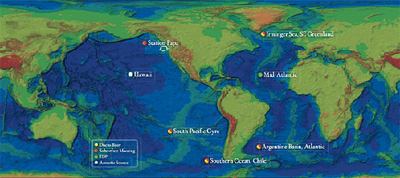Coastal and Global Ocean Observatory Partnership Announced Following Related Cyberinfrastructure Grant to Calit2 and Scripps
San Diego, CA, August 23, 2007 -- Calit2 and Scripps Institution of Oceanography are leading an effort to develop cyberinfrastructure for ocean observatories, and now Scripps is partnering with Woods Hole Oceanographic Institution (WHOI) and Oregon State University (OSU) on coastal and global components that will be linked via that cyberinfrastructure.
|
The Joint Oceanographic Institutions (JOI) has awarded a $97.7 million contract to an academic partnership led by WHOI to support the development, installation and initial operation of the coastal and global components of the National Science Foundation's Ocean Observatories Initiative (OOI). The WHOI partnership includes Scripps at the University of California, San Diego, and OSU's College of Oceanic and Atmospheric Sciences. [For details and the news release about the latest contract award, click here .]
The award completes the management team to construct and implement the $331.5 million OOI Network. "This initiative is a major investment that will transform our understanding of the ocean," said JOI President Steven Bohlen. "It will contribute to tremendous advances in our understanding of how Earth works."
OOI Cyberinfrastructure
The overall OOI Network spans global, regional and coastal scales, linked by a system-wide cyberinfrastructure. In May, JOI selected UC San Diego to design and construct information technology and networking for the initiative. The initial $29 million OOI Cyberinfrastructure award was for six years, and total funding may reach more than $42 million over the course of the planned 11-year project. [To read JOI's May 2007 news release, click here .] The UCSD division of the California Institute for Telecommunications and Information Technology (Calit2) is managing the project and, together with Scripps, will design and build the cyberinfrastructure.
That cyberinfrastructure will transport real-time data streams at up to one gigabit per second from a variety of ocean-dwelling sensors and other instruments. The data will be available in real time via dedicated, high-speed Internet links to researchers, teachers and the public. Two-way connectivity will also allow scientists to operate robots on the ocean floor interactively—from the relative comfort of their campus laboratories. Many of these functions will be undertaken automatically without human intervention. The bulk of the cyberinfrastructure work will be done by computer scientists and engineers at Calit2, in conjunction with scientists at Scripps. The cyberinfrastructure project will also draw on expertise in grid computing and large-scale distributed networks at both organizations as well as the university’s San Diego Supercomputer Center (SDSC) and National Center for Microscopy and Imaging Research (NCMIR).
JOI published the OOI's Conceptual Network Design, developed with input from the research community, in August 2006; a modified version of this plan was distributed in March 2007. In May 2007, when JOI announced the cyberinfrastructure award to UC San Diego, it also issued an award to the University of Washington to lead OOI's regional component. Each partner will contribute to JOI's ongoing development of the preliminary design in preparation for a review scheduled for late 2007. OOI is the U.S. science community's contribution to a broader national and international effort to establish a Global Ocean Observing System (GOOS).
"The ability to make long-term measurements in the coastal and global ocean provides an opportunity to truly understand ocean variability, hazards, and climate change in response to natural events and human activity," said Scripps Institution of Oceanography Director Tony Haymet.
JOI is a consortium of premier oceanographic research institutions that serves the U.S. scientific community through management of large-scale, global research programs in the fields of marine geology and geophysics and oceanography. Known for leadership of U.S. scientific ocean drilling and ocean observing initiatives, JOI has helped facilitate discovery and advance global understanding of the Earth and its oceans through effective systems engineering and program management.
Related Links
Joint Oceanographic Institutions
August 2007 JOI News Release
May 2007 Cyberinfrastructure News Release
National Science Foundation
Scripps Institution of Oceanography

